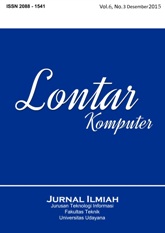Implementasi Metode Clustering DBSCAN pada Proses Pengambilan Keputusan
Abstrak
Spatial Data Clustering merupakan salah satu teknik penting pada data mining yang digunakan untuk mendapatkan informasi atau pengetahuan pada data spasial dalam jumlah yang besar dari berbagai aplikasi. Salah satu teknik yang menjadi pelopor perkembangan algoritma clustering pada data spasial adalah DBSCAN. Penelitian ini berfokus pada pengimplementasian Metode DBSCAN pada proses pengambilan keputusan untuk membantu perusahaan menentukan pelanggan potensialnya. Hasil uji coba pada penelitian ini menunjukkan bahwa Metode DBSCAN telah berhasil melakukan proses clustering untuk membantu proses pengambilan keputusan dalam penentuan pelanggan potensial dengan membentuk sejumlah cluster.
##plugins.generic.usageStats.downloads##
Referensi
[2] Shekhar S, Zhang P, Huang Y, and Vatsavai RR, “Trends in spatial data mining. Data mining: Next generation challenges and future directions,” pp. 357–380, 2003.
[3] Matheus CJ, Chan PK, and Piatetsky-Shapiro G, “Systems for Knowledge Discovery in Databases,” IEEE Trans. Knowl. Data Eng., vol. 5, no. 6, pp. 903–913, 1993.
[4] Mumtaz K, “An Analysis on Density Based Clustering of Multi Dimensional Spatial Data,” Indian Journal of Computer Science and Engineering (IJCSE), vol. 1, no. 1, pp. 8–12, 2010.
[5] Zakrzewska D and Murlewski J, “Clustering Algorithms for Bank Customer Segmentation,” in Proceedings of 5th Int. Conference on Intelligent Systems Design and Applications, Poland, 2005, pp. 197–202.
[6] H. Xiaohui, “A New Customer Segmentation Framewok Based on Biclustering Analysis,” J. Softw., vol. 9, no. 6, pp. 1359–1366, 2014.
[7] P. Tan, Introduction to Data Mining. Boston: Pearson Education, 2006.
The Authors submitting a manuscript do so on the understanding that if accepted for publication, the copyright of the article shall be assigned to Jurnal Lontar Komputer as the publisher of the journal. Copyright encompasses exclusive rights to reproduce and deliver the article in all forms and media, as well as translations. The reproduction of any part of this journal (printed or online) will be allowed only with written permission from Jurnal Lontar Komputer. The Editorial Board of Jurnal Lontar Komputer makes every effort to ensure that no wrong or misleading data, opinions, or statements be published in the journal.
 This work is licensed under a Creative Commons Attribution 4.0 International License.
This work is licensed under a Creative Commons Attribution 4.0 International License.























